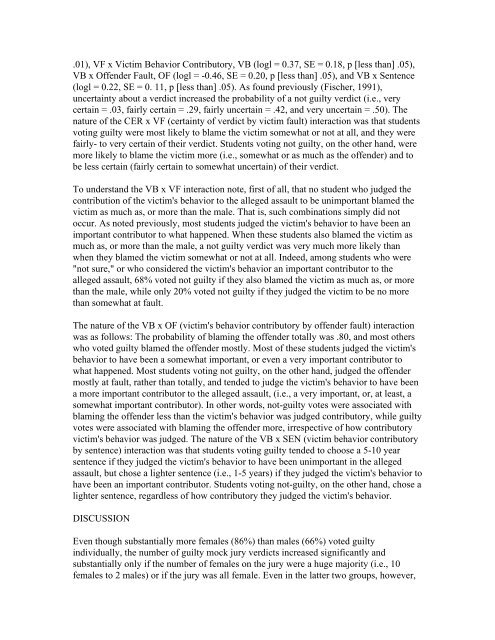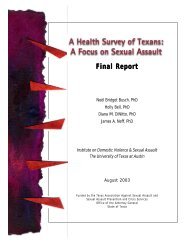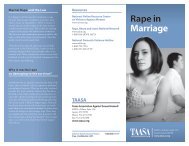Gender effects on individual verdicts and on mock jury verdicts in a ...
Gender effects on individual verdicts and on mock jury verdicts in a ...
Gender effects on individual verdicts and on mock jury verdicts in a ...
You also want an ePaper? Increase the reach of your titles
YUMPU automatically turns print PDFs into web optimized ePapers that Google loves.
.01), VF x Victim Behavior C<strong>on</strong>tributory, VB (logl = 0.37, SE = 0.18, p [less than] .05),<br />
VB x Offender Fault, OF (logl = -0.46, SE = 0.20, p [less than] .05), <strong>and</strong> VB x Sentence<br />
(logl = 0.22, SE = 0. 11, p [less than] .05). As found previously (Fischer, 1991),<br />
uncerta<strong>in</strong>ty about a verdict <strong>in</strong>creased the probability of a not guilty verdict (i.e., very<br />
certa<strong>in</strong> = .03, fairly certa<strong>in</strong> = .29, fairly uncerta<strong>in</strong> = .42, <strong>and</strong> very uncerta<strong>in</strong> = .50). The<br />
nature of the CER x VF (certa<strong>in</strong>ty of verdict by victim fault) <strong>in</strong>teracti<strong>on</strong> was that students<br />
vot<strong>in</strong>g guilty were most likely to blame the victim somewhat or not at all, <strong>and</strong> they were<br />
fairly- to very certa<strong>in</strong> of their verdict. Students vot<strong>in</strong>g not guilty, <strong>on</strong> the other h<strong>and</strong>, were<br />
more likely to blame the victim more (i.e., somewhat or as much as the offender) <strong>and</strong> to<br />
be less certa<strong>in</strong> (fairly certa<strong>in</strong> to somewhat uncerta<strong>in</strong>) of their verdict.<br />
To underst<strong>and</strong> the VB x VF <strong>in</strong>teracti<strong>on</strong> note, first of all, that no student who judged the<br />
c<strong>on</strong>tributi<strong>on</strong> of the victim's behavior to the alleged assault to be unimportant blamed the<br />
victim as much as, or more than the male. That is, such comb<strong>in</strong>ati<strong>on</strong>s simply did not<br />
occur. As noted previously, most students judged the victim's behavior to have been an<br />
important c<strong>on</strong>tributor to what happened. When these students also blamed the victim as<br />
much as, or more than the male, a not guilty verdict was very much more likely than<br />
when they blamed the victim somewhat or not at all. Indeed, am<strong>on</strong>g students who were<br />
"not sure," or who c<strong>on</strong>sidered the victim's behavior an important c<strong>on</strong>tributor to the<br />
alleged assault, 68% voted not guilty if they also blamed the victim as much as, or more<br />
than the male, while <strong>on</strong>ly 20% voted not guilty if they judged the victim to be no more<br />
than somewhat at fault.<br />
The nature of the VB x OF (victim's behavior c<strong>on</strong>tributory by offender fault) <strong>in</strong>teracti<strong>on</strong><br />
was as follows: The probability of blam<strong>in</strong>g the offender totally was .80, <strong>and</strong> most others<br />
who voted guilty blamed the offender mostly. Most of these students judged the victim's<br />
behavior to have been a somewhat important, or even a very important c<strong>on</strong>tributor to<br />
what happened. Most students vot<strong>in</strong>g not guilty, <strong>on</strong> the other h<strong>and</strong>, judged the offender<br />
mostly at fault, rather than totally, <strong>and</strong> tended to judge the victim's behavior to have been<br />
a more important c<strong>on</strong>tributor to the alleged assault, (i.e., a very important, or, at least, a<br />
somewhat important c<strong>on</strong>tributor). In other words, not-guilty votes were associated with<br />
blam<strong>in</strong>g the offender less than the victim's behavior was judged c<strong>on</strong>tributory, while guilty<br />
votes were associated with blam<strong>in</strong>g the offender more, irrespective of how c<strong>on</strong>tributory<br />
victim's behavior was judged. The nature of the VB x SEN (victim behavior c<strong>on</strong>tributory<br />
by sentence) <strong>in</strong>teracti<strong>on</strong> was that students vot<strong>in</strong>g guilty tended to choose a 5-10 year<br />
sentence if they judged the victim's behavior to have been unimportant <strong>in</strong> the alleged<br />
assault, but chose a lighter sentence (i.e., 1-5 years) if they judged the victim's behavior to<br />
have been an important c<strong>on</strong>tributor. Students vot<strong>in</strong>g not-guilty, <strong>on</strong> the other h<strong>and</strong>, chose a<br />
lighter sentence, regardless of how c<strong>on</strong>tributory they judged the victim's behavior.<br />
DISCUSSION<br />
Even though substantially more females (86%) than males (66%) voted guilty<br />
<strong><strong>in</strong>dividual</strong>ly, the number of guilty <strong>mock</strong> <strong>jury</strong> <strong>verdicts</strong> <strong>in</strong>creased significantly <strong>and</strong><br />
substantially <strong>on</strong>ly if the number of females <strong>on</strong> the <strong>jury</strong> were a huge majority (i.e., 10<br />
females to 2 males) or if the <strong>jury</strong> was all female. Even <strong>in</strong> the latter two groups, however,
















